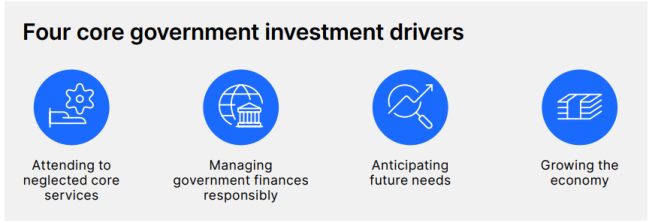Every Australian government agency has a digital strategy prioritising the shift from legacy systems to contemporary integrated, scalable and resilient solutions.
Despite this, many agencies face significant challenges migrating from outdated applications and databases to contemporary solutions, even with awareness of the risks and costs of the status quo.
Agencies can be held back for several reasons, including insufficient resources, concerns over business continuity, and difficulties in complying with ever-growing information preservation, privacy and security requirements such as the Australian Privacy Principles and Security of Critical Infrastructure Act 2018. These challenges can trap agencies in a vicious cycle of reliance on legacy systems that are difficult to maintain, ineffective, and inefficient.
The everlasting cybersecurity threat, ballooning maintenance costs, and the inability of legacy applications and databases to meet agency objectives, are prompting leaders to speed up efforts to transition to contemporary platforms. And let’s not forget the ever-present need to meet evolving regulatory requirements like the Essential Eight, APPs and SOCI Act.
The question is how to transition successfully.
Build an unassailable business case
Governments are seeking to scale back existing digital and ICT projects and are approving fewer major new initiatives. In this tight budget environment, agencies need to present robust business cases to secure funding.
Agencies can align proposals with one or more of the government’s four core investment drivers to increase the likelihood of approval, whether pitching to agency executives or competing in the cabinet budget process.

Managing government finances responsibly
As government debt rises, leaders are under pressure to reduce costs and reallocate resources to maximise benefits to citizens. Cost optimisation is a key driver for transitioning to contemporary solutions, with reliance on legacy systems often leading to inefficient use of resources.
Although estimating the percentage of agency technology funding spent on legacy applications is difficult, it is thought that legacy modernisation accounts for a major share of investment demand – ranging between 40 and 60 per cent. By retiring legacy systems, resources can be redirected to solutions that improve service delivery or reduce administrative overheads.
Align with Whole of Government directives
Agencies are more successful in decommissioning legacy systems when their strategies align with Whole of Government directives. This alignment allows them to leverage reusable components and resources, including support from the WofG digital agency. It also increases their chances of accessing funding through WofG ICT and digital funding pools.
Four jurisdictions – Western Australia, South Australia, New South Wales, and Tasmania – have dedicated budget mechanisms to encourage ICT and digital projects that support WofG priorities. These mechanisms, with their funding pools, can reject submissions that do not align with government objectives.
All Australian jurisdictions now have a WofG ICT architecture. Although expressed differently across jurisdictions, these typically require agencies to share already-established components, go cloud-first and focus on interoperability and simplicity.
Take an iterative approach to modernisation
Australian governments have no appetite for “big bang” projects. Instead, governments prefer smaller and more manageable projects to reduce risk and speed up the delivery of benefits. In the past, initiatives to retire legacy systems were often accompanied by cost overruns, as unforeseen migration challenges and insufficient planning led projects to exceed schedules and budgets. A further reason for the change is a renewed focus on SMEs and local suppliers.
Focusing on iterative progress creates opportunities for smaller businesses to participate as they may not have the scale of larger suppliers, with agencies deeming them “too risky” for high-value projects. The iterative approach can also minimise disruption to user experience, as new features are introduced incrementally. This can help in organisational cultures that resist change by taking internal personnel along the journey.
Focus on getting agency information in order
A key challenge when retiring legacy systems and transitioning to modern platforms is that inadequate data standardisation, compatibility, and quality, which can lead to integration difficulties, increased migration costs, and potential disruptions in business operations. This is particularly challenging when data and information are spread out across multiple generations of technology.
Therefore, extensive planning is vital before retiring legacy systems, with consideration given to clearly defining the purpose of the initiative and addressing data and information challenges.
Data management plans are a best practice approach to ensuring that agency data and information are well-managed across their lifecycle and that adequate systems support agency objectives. DMPs include a statement of the agency’s objectives for collecting, creating or storing data or information and how this will support an activity, project or business area.
Focus on project governance and benefits realisation
Establishing effective governance is crucial as legacy retirement projects often encounter a variety of challenges, including insufficient documentation, difficult integrations, and complicated middleware implementations.
By having clear objectives and continuously aligning efforts to achieve them, agencies can prevent scope creep and ensure that the project delivers the expected benefits. Personnel must also secure support from senior leadership by clearly articulating the strategic value and anticipated benefits of the transition.
Developing this support from the project’s outset is critical to maintain momentum. Additionally, outdated security architectures risk exposing sensitive information during migrations, necessitating meticulous planning and security controls including access controls, encryption and continuous monitoring to detect and mitigate potential threats.
Successfully retiring legacy systems involves more than adopting new solutions; it requires strategic planning, robust governance, and alignment with government directives. By following the outlined strategies, agencies can effectively transition to modern platforms, enhancing service delivery and operational efficiency.
Extract from Retiring legacy applications and databases: Proven strategies for government agencies – a white paper commissioned by OpenText and developed by Intermedium




Leave a Reply